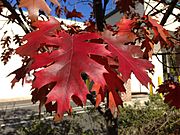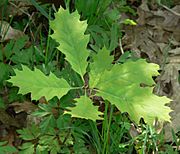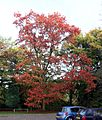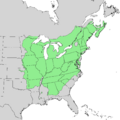Northern red oak facts for kids
Quick facts for kids Northern red oak |
|
|---|---|
 |
|
| Northern red oak in autumn | |
| Conservation status | |
| Scientific classification | |
| Genus: |
Quercus
|
| Species: |
rubra
|
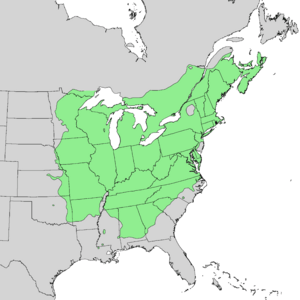 |
|
| Synonyms | |
|
|
The northern red oak (scientific name: Quercus rubra) is a type of oak tree. It belongs to the red oak group. This tree is originally from North America. You can find it in the eastern and central United States, and in southeast and south-central Canada.
Its natural home stretches from the Great Lakes in the north, all the way east to Nova Scotia. It goes south to states like Georgia, Mississippi, Alabama, and Louisiana. To the west, it reaches Oklahoma, Kansas, Nebraska, and Minnesota. People have also planted it in parts of Western Europe. There, you can often see it in gardens and parks. This tree likes good soil that is a little bit acidic.
It's often just called "red oak." But its full name, "northern red oak," helps tell it apart from the southern red oak. Sometimes, people also call it the "champion oak." It is the state tree of New Jersey. It's also the provincial tree of Prince Edward Island in Canada.
Contents
What Does a Northern Red Oak Look Like?
In many forests, this tree grows very straight and tall. It can reach about 28 meters (92 feet) high. Some even grow up to 43 meters (141 feet) tall! Its trunk can be 50 to 100 centimeters (20 to 39 inches) wide. Trees that grow in open spaces might not be as tall. But they can have a thicker trunk, sometimes up to 2 meters (6.6 feet) wide.
The northern red oak has strong branches. They grow straight out from the trunk. This forms a narrow, rounded top. It grows quickly and can handle many different types of soil. It prefers well-drained areas near streams.
Under good conditions and with lots of sun, a northern red oak grows fast. A 10-year-old tree can already be 5 to 6 meters (16 to 20 feet) tall. These trees can live for a very long time, sometimes up to 400 years! One tree was found to be 326 years old in 2001.
It's easy to spot a northern red oak by its bark. The bark has ridges that look like they have shiny stripes down the middle. Some other oaks have this look higher up on the tree. But the northern red oak is the only one with these stripes all the way down its trunk.
The northern red oak is very common in the northeastern US. It's second only to the pin oak. Red oaks are more common today than they were when Europeans first settled in North America. This is because logging reduced the number of white oaks, which used to be more dominant.
Like most oaks that lose their leaves, the northern red oak's leaves appear in spring. This happens when the days get about 13 hours long. This timing depends on the amount of daylight, not the temperature. Because of this, in colder places, late spring frosts can sometimes kill the flowers. This means no acorns will grow that year. The flowers (called catkins) and leaves grow at the same time.
Acorns take two growing seasons to develop on the tree. They fall from the tree in early October. The leaves start to drop when the days become shorter than 11 hours. The exact timing of leaves appearing and falling can change. It can vary by up to three weeks between the northern and southern US. New seedlings sprout in spring when the soil temperature reaches 21°C (70°F).
Here are some details about the northern red oak:
- Bark: It's dark reddish-gray-brown. It has wide, thin, rounded ridges that are scaly. On young trees, the bark is smooth and light gray. It contains a lot of tannin.
- Wood: The wood is pale reddish-brown, with darker sapwood. It's heavy, hard, and strong. It can crack when drying. But if treated carefully, it can be used for furniture. It's also used in building houses.
- Winter buds: These are dark chestnut brown. They are oval-shaped and pointed, usually about 6 millimeters (0.24 inches) long.
- Leaves: They grow alternately on the branch. They have seven to nine lobes. They are 5 to 10 inches (13 to 25 cm) long and 4 to 6 inches (10 to 15 cm) wide. The lobes are usually less deeply cut than on other red oaks. The leaves are pink and soft when they first appear. When fully grown, they are dark green and smooth on top. In autumn, they turn a rich red, sometimes brown. The leaf stem and main vein are often red in summer and early autumn.
- Acorns: They take about 18 months to grow after the tree is pollinated. They grow alone or in pairs. The nut is oval-shaped with a flat base and a pointed top. It's 1.5 to 3 cm (0.59 to 1.18 inches) long. They are green at first, then turn nut-brown. The cup is shallow and covers only the base of the nut. The kernel inside is white and very bitter. Even though they are bitter, deer, squirrels, and birds eat them.
Unlike white oak acorns, red oak acorns need to be cold for at least three months (below 4°C or 40°F) before they can sprout. They also take two years to fully develop on the tree.
Northern Red Oak in Nature
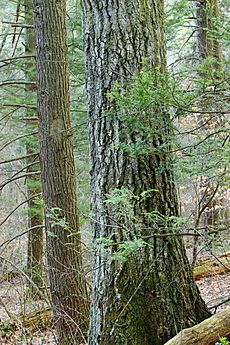
Over the past few decades, the northern red oak has faced some challenges. These include diseases, insects eating them, and fewer ways for their seeds to spread. These problems have made it harder for the species to grow in the Northeast US and Europe. Because of how it reacts to different environments, the northern red oak is a good tree to study. Scientists learn about how trees live with other living things, how their seeds spread, and how they get used to new places.
Tree Troubles: Pests and Diseases
A disease called canker, caused by the fungus Diplodia corticola, has become a big problem. In the last ten years, it has caused leaves to turn brown, bark to crack and "bleed," and many trees to die in the northeastern United States.
The northern red oak is also very likely to get sick from other plant fungi. These are Phytophthora cinnamomi and Phytophthora ramorum. These fungi cause serious red-black sores (cankers) on the tree's trunk. Both of these fungi grow better in warmer weather. So, northern red oak trees in California, France, and northern Spain have more fungal infections. Another major disease is Oak Wilt, caused by the fungus Ceratocystis fagacearum. This disease is found in eastern North America and can kill trees quickly.
Who Eats Northern Red Oak Acorns?
In Europe, northern red oak acorns have become food for several types of moths. This helps the moths find more food sources. But it also means fewer acorns are left to sprout. This has led to less seed spreading by animals in places like Poland.
Also, it's harder for northern red oak seeds to spread in Europe. Animals that usually spread seeds, like the European jay and wood mouse, prefer local oak species. Northern red oak acorns have a lot of tannin. This chemical makes them taste bitter. This bitter taste makes them less appealing for many animals to eat.
Helpful Fungi for Oaks
Northern red oaks have special relationships with fungi called ectomycorrhizae. These relationships help the trees grow faster. Certain fungi, which grow at the base of oak trunks, have been shown to help northern red oaks grow. These fungi are specific to Quercus rubra and Quercus montana. They mostly help the trees grow when they infect them.
Northern Red Oak in Europe: An Introduced Species
The northern red oak was brought to Europe in the 1700s. Since then, it has spread and grown naturally across most of western and central Europe.
It has become one of the most common invasive species in western and central Europe. It has spread to many areas, including Belgium, Germany, Northern Italy, Lithuania, Poland, Ukraine, European Russia, the Urals, and Western Siberia. You often find northern red oaks at the edges of forests in Europe. This is where there's enough light, and where animals can help spread their seeds.
The tree is popular in Europe because it grows fast and is a good source of timber. However, its presence has been linked to lower amounts of important minerals in the soil. It has also been linked to fewer types of native oak species, like Quercus robur.
What Are Northern Red Oaks Used For?
The northern red oak is one of the most important oaks for timber in North America. Good quality red oak wood is very valuable for lumber and thin sheets of wood called veneer. Logs that aren't perfect are used as firewood.
Other types of red oaks are also cut and sold as "red oak." But their wood might not be as high quality. These include eastern black oak, scarlet oak, pin oak, Shumard oak, and southern red oak.
Red oak wood is used for many things in construction. This includes flooring, veneer, indoor trim, and furniture. It's also used for railroad ties and fence posts.
The grain of red oak wood is very open. This means that smoke can actually be blown through a flat-sawn board from one end to the other! Because of this, it can easily absorb moisture. This makes it not suitable for outdoor uses like building boats or outdoor trim.
You can collect the acorns in autumn. First, you shell them. Then, you tie them in a cloth and soak them in water to remove the bitter taste. After that, you can eat them whole or grind them into a meal.
Growing Northern Red Oaks in Gardens
Quercus rubra is planted in parks and large gardens as a beautiful tree. It's not planted as often as the pin oak. This is because it grows a deep main root (called a taproot) and becomes hard to move once it's established. However, new types of growing pots have made it easier to start seedlings with taproots than in the past.
How Northern Red Oaks Handle Stress
Northern red oak seedlings often don't survive in areas of the northeast that get spring frosts, especially in Massachusetts. Acorns from oaks in these colder regions are usually smaller. This is an adaptation to the frost. However, the smaller seedlings mean fewer chances for animals to eat and spread the seeds.
Flooding can also be a big problem for the northern red oak. When there's flooding, the tree's ability to move nutrients and perform photosynthesis (make food from sunlight) decreases. But this only happens after many days of flooding. This shows that the northern red oak has some resistance to too much water.
The northern red oak has also developed ways to handle heat stress. This is especially true in forests in the Southeastern United States. There, summer heat waves can bring temperatures above 40°C (104°F). The leaves of the northern red oak can adjust to these high temperatures. They keep making food even when it's very hot. They also continue to perform photosynthesis well even when there are high levels of carbon dioxide, which often happen with higher temperatures.
Meet Some Famous Northern Red Oaks!
- Ashford Oak: This is a very large Northern Red Oak in Ashford, Connecticut. Some of its branches have fallen because it's so old. But it's still amazing to see! The trunk is 8 meters (26 feet) around. Its root-knees are also very impressive. You can find this oak on Giant Oak Lane, off U.S. Highway 44. There are other large oaks nearby too.
- Chase Creek Red Oak: This forest tree grows on a very rich, steep slope in Anne Arundel County, Maryland. It's a tree that was cut low and has three main stems growing from the stump. It was named the state champion oak in Maryland in 2002. Its trunk is 6.7 meters (22 feet) around at chest height. It's 41.5 meters (136 feet) tall and its branches spread 29.9 meters (98 feet) wide.
- Shera-Blair Red Oak: This grand red oak tree is on Shelby Street in the South Frankfort neighborhood of Franklin County, Kentucky. It's the biggest red oak tree in the oldest neighborhood in Frankfort, Kentucky. It's in the backyard of a house built in 1914. The trunk is 6.4 meters (21 feet) around at chest height. The trunk goes up more than 12 meters (40 feet) before the branches start. It's estimated to be 40 meters (130 feet) tall.
Images for kids
-
Mossy trunk of a large, old-growth individual surrounded by hemlocks within the Jakey Hollow Natural Area of Weiser State Forest in Columbia County, Pennsylvania
See also
 In Spanish: Roble rojo americano para niños
In Spanish: Roble rojo americano para niños



